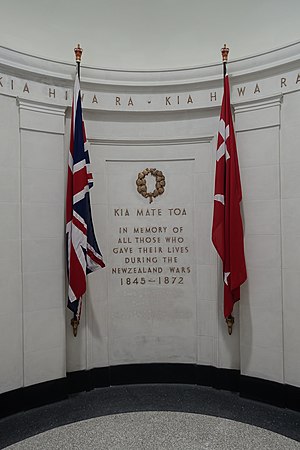Anglo-Maori wars
| New Zealand Wars | |||||||||
|---|---|---|---|---|---|---|---|---|---|
 Memorial in the Auckland War Memorial Museum for those who died, both European and Māori, in the New Zealand Wars. "Kia mate toa" can be translated as "fight unto death" or "be strong in death", and is the motto of the Otago and Southland Regiment of the New Zealand Army. The flags are that of Gate Pā and the Union Flag. |
|||||||||
|
|||||||||
| Belligerents | |||||||||
| Māori | Māori | ||||||||
| Strength | |||||||||
| 18,000 (peak deployment) | 5,000 (peak deployment) | ||||||||
| Casualties and losses | |||||||||
| 745 killed (including civilians) | 2,154 killed (including civilians) | ||||||||
The New Zealand Wars were a series of armed conflicts that took place in New Zealand from 1845 to 1872 between the New Zealand government and the Māori. Until at least the 1980s, European New Zealanders referred to them as the Māori wars; the historian James Belich was one of the first to refer to them as the "New Zealand wars", in his 1987 book The New Zealand wars and the Victorian interpretation of racial conflict.
Though the wars were initially localised conflicts triggered by tensions over disputed land purchases, they escalated dramatically from 1860 as the government became convinced it was facing united Māori resistance to further land sales and a refusal to acknowledge Crown sovereignty. The colonial government summoned thousands of British troops to mount major campaigns to overpower the Kīngitanga (Māori King) movement and also acquire farming and residential land for British settlers. Later campaigns were aimed at quashing the so-called Hauhau movement, an extremist part of the Pai Mārire religion, which was strongly opposed to the alienation of Māori land and eager to strengthen Māori identity.
At the peak of hostilities in the 1860s, 18,000 British troops, supported by artillery, cavalry and local militia, battled about 4,000 Māori warriors in what became a gross imbalance of manpower and weaponry. Although outnumbered, the Māori were able to withstand their enemy with techniques that included anti-artillery bunkers and the use of carefully placed pā, or fortified villages, that allowed them to block their enemy's advance and often inflict heavy losses, yet quickly abandon their positions without significant loss. Guerilla-style tactics were used by both sides in later campaigns, often fought in dense bush. Over the course of the Taranaki and Waikato campaigns, the lives of about 1,800 Māori and 800 Europeans were lost, and total Māori losses over the course of all the wars may have exceeded 2,100.
...
Wikipedia
